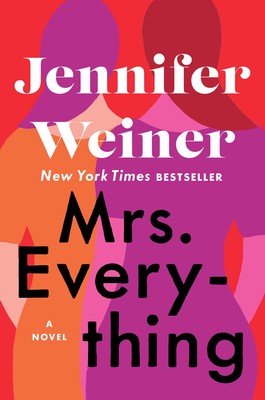October 10, 2019
The Girl Who Rode a Shark, by Ailsa Ross and Amy Blackwell
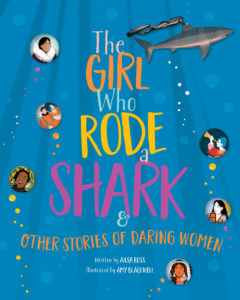
I’m not yet bored of stories of brave and uncommon women, and this is not even a genre that began with Good Night Stories for Rebel Girls. Virginia Woolf published several biographical essay throughout her career—it was from “Lives of the Obscure,” in The Common Reader, that I learned about the Victoria entomologist Eleanor Ormerod, for example, and without Woolf we wouldn’t even know about Shakespeare’s Sister at all. Truth be told, I actually found Good Night Stories... a bit wanting…but that’s because I’d read Rad Women Worldwide before it, and liked it so much better.
But another similar book, The Girl Who Rode a Shark, by Ailsa Ross (who lives in Alberta!) and Amy Blackwell, has managed to live up to my expectations. My favourite bit is the Canadian content—we’re almost at the Roberta Bondar essay. And Indigenous hero Shannon Koostachin is included in “The Activists” chapter.
The women profiled in the book come from places all over the world, include many women of colour, and also women with disabilities. Even better—while many of the profiles are of historical figures, just as many are contemporary, young women who are out there doing brave and groundbreaking things as we’re reading. A few of these figures are familiar, but more are new to us, and their stories are made vivid and compelling through the book’s beautiful artwork and smart and engaging prose.
September 26, 2019
On Beauty
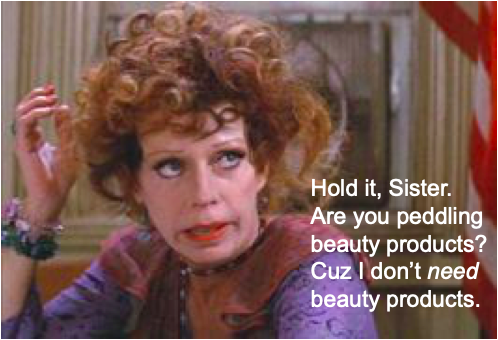
If there is one mistake of mine that it’s really important to me that my children could learn from, it is this: leave your eyebrows alone. More important than not smoking or getting ill-advised tattoos, because there is no coming back from eyebrow ruin. During the early years of my life, I had perfectly acceptable, unremarkable eyebrows, and I could have stayed that way, were it not for a teenaged need to perform womanhood with stupid grooming rituals.
So I went and got my eyebrows waxed, and waxed, and waxed and waxed, and there was a point in 2001 where they were tiny little lines, skinnier than I’ve ever been, and there was also the women who did my brows the day before my wedding who nicked me with the tweezers and made me bleed, so I gave her an extra big tip so she would feel less bad about the whole thing, and being a woman is so idiotic.
And then one day a couple of years ago, I decided I didn’t want to wax my eyebrows anymore. I didn’t even want to tweeze them anymore, standing before the bathroom mirror, hair-by-hair, each pluck making me sneeze. I don’t have time for that, because it always grows back. The same reason I’ve sworn off dieting, and colouring my hair, and running on treadmills—the whole thing is Sisyphean, and I refuse to be pushing a boulder for the rest of my life. These are losing battles, and I will not engage.
But the result now is that I have terrible eyebrows, sprawling and patchy. Would be that after all the waxing, my eyebrows would have thinned out altogether, but instead they’ve grown back in wide but with bald spots, a shape that is so far from a shape, and I just don’t care. And also I do, because I’m already on my fourth paragraph writing about it. But I just can’t go in for the incessant demands of grooming, and most of the time I don’t, which is one great benefit of being in a romantic partnership with someone who is terrifically far-sighted.
I was listening to a podcast today (which is the way that I start most of my sentences lately) when the host came on with an ad for some kind of skin care product I wasn’t paying proper attention to, and she talked about how much she loved her nightly skin care regimen, how it was just so fantastic that it gave her “me-time,” and I almost died of despair right then. The saddest thing I’ve ever heard, though perhaps I’m reading more into this than I should be. It is possible that no podcast host is quite as enthusiastic about the product she’s endorsing as she sounds like she is, and I actually really hope she isn’t, because that’s the saddest excuse for “me-time” I’ve ever heard.
It is also possible that she has nicer skin than I do. Most people do. Earlier this year, I turned down a prescription for rosacea from my dermatologist, so I’m hardly an expert on any of this. I’m just kind of lazy when it comes to grooming, and also would prefer to squander all my money on books instead.
Which is not to pass any judgement on those people who heavily invest in their aesthetic appearance—they’re are a million ways to be a woman after all, and who am I to tell another person what to do with her body, but this is kind of just my point, that the whole world is actually telling us what to do with our bodies, and I wonder sometimes if the whole thing is a conspiracy to keep us from doing anything more useful.
All those boulders we’re pushing, even once we’ve refused to push the boulders. I have no idea what liberation might look like.
August 2, 2019
Mrs. Everything, by Jennifer Weiner
I had an oddly optimistic revelation about the world the other day—odd, because I haven’t had an optimistic revelation about the world for at least four years—which was that when people look back on the literature published in the second half of this decade, they’re going to be thinking, “Good gracious, the Patriarchy (RIP) on its last legs must have been quaking in its ugly boots.”
Because the books are so feminist, and furious, confronting racism and violence against women. Fiction and nonfiction, commercial and literary—I promise I haven’t been even deliberately seeking them out. But almost every book I’ve picked up this year, and certainly every one that I have loved, has been staring the patriarchy in the face and having none of it. Refusing to submit, to be polite, to keep things uncomplicated, to tolerate the status quo.
And in 25 years—after the current US president has been found dead on a toilet, the stupid red hats have disintegrated (cheap production will do that), and a few remaining rat-men have built an all-male colony out in the ocean on an island constructed from millions of copies of 12 Rules For Life (I would LOVE to know the number of people who bought that book versus number of people who finished it; is that why it keeps selling? Because the reader hopes a different copy might prove worthy of their attention?)—these books will be what remains of this time, the culture we made.
It’s sort of like the illusion I once bought as a young person that the 1960s was only groovy and folk songs, instead of political assassinations, endless war, and racial violence. You know the expression, “You had to be there.” In this case, it’s kind of the opposite. It’s even better if you weren’t.
And this is the gist of Jennifer Weiner’s latest novel Mrs. Everything, her thirteenth novel and her tour de force, a novel that reminded me of recent work by Meg Wolitzer and Lauren Groff. My one criticism that it started out unsteady, the story of a family in the 1950s whose American Dream is coming true, a mother and father and two daughters who’ve just moved into red brick house in Detroit. The characters are a bit stock at this point, the good girl and the bad girl, their disapproving mother, some manufactured drama…but then the novel starts going and it never stops.
What I love best about this novel is what I love best about any narrative that features more than one woman (which is the only kind of narrative I love at all, to be honest). That the women in the book are not foils, that their characters and narrative development is sufficiently complicated, and that their relationship is as much supportive as it is fraught. And such is the way with Jo and Bethie Kauffman, the two sisters who grow up in that house in Detroit. One is posed to be the good girl and the other is the problem, and then fate intervenes and neither one ends up on the trajectory that she, the reader, or anyone else imagines for her. Jo will become a suburban housewife, Bethie the counterculture rebel, but neither archetype is the whole story, and the whole story is mostly that there is no right way to be a woman. We live in a society that’s going to mess with each and every one of us.
The novel takes the sisters from the 1950s through to the present day, and beyond, and its fabulous momentum builds as it goes. The sisters come together, are pulled apart, face heartbreak and trauma, keep going, keep learning and growing wiser all the time. This is a story of women, and civil rights, and the rise of LGBTQ rights as well.
The constants? Weight. It’s not a theme of the book, but it’s always in the background, as its always in the background (maybe not so far back) of the lives of almost every women I know. Feeling fat when you’re not, and then actually being fat—is it not remarkable that women are able to feel badly about themselves no matter what their size? It’s a fascinating narrative strand in the book. As is the idea of mothers wanting something different and better for their daughters than what they themselves have had to go through, but the thing about daughters (who are women, who are people) is that they don’t always want to dream the dreams their parents dream for them, and they have to learn from their own mistakes, and also none of us want to entirely believe that we’ll be subject to the same rules our mothers were. We’ll do it different, this time, and we do, but some things stay the same, as Mrs. Everything serves to underline.
As Michele Landsberg explains in her book Writing the Revolution: “Because our history is constantly overwritten and blanked out…., we are always reinventing the wheel when we fight for equality.”
But I would like to believe there is something different about the current moment we’re in, when women are finally courageous enough to call out discrimination, abuse and violence, to finally call things by their names. Because in not being able to do so before, were we blanking out our own history, our own experiences? Doing the work of the Patriarchy for it, but no longer. I hope.
Mrs. Everything misses absolutely nothing.
July 31, 2019
Stop Waffling, and Write
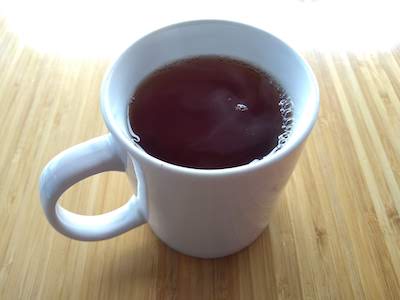
I finally read Brigid Schulte’s essay in The Guardian, “What is women’s greatest enemy? Lack of time for themselves,” an essay I’d seen many people sharing online last week. And to be honest, once I got to it, I found the piece a bit…slight? Understanding why it had resonated with so many women for sure, but it also frustrated me, and made me impatient. I wanted more. I wanted something less waffley (no offence to waffles) and less cribbed from A Room of One’s Own, because it’s been 90 years, and surely we can do better than, “What would happen if…” and thought experiments about Shakespeare’s sister.
(What might you have written had you not sat down to write the piece about how women don’t take enough time to sit down and write?)
I’ve spent the last few weeks completing the modules of my blogging course, whose goal is to deliver women the confidence (the nerve?) to carve out their own little space online, to emphasize to them that their voices matter and so do their stories, and that the world needs both these things. I’ve written 25,000 words that I’m proud of and excited to share very soon that I hope will inspire and motivate people who are blog-curious or at least need a little jolt to get their blogging spark back…but at the heart of it all there really is just one point, and it’s this one: You just have to do it.
And you know what? We can blame the patriarchy. (We definitely SHOULD blame the patriarchy. See Toi Smith: ‘Let’s stop calling it “mom guilt” because that’s bullshit and not actually a thing. Let’s start calling it what it really is: internalized patriarchy, capitalism, and white supremacy which has conditioned women to believe that once we become a mother our pleasure isn’t ours, that our joy isn’t ours, that our creative force isn’t ours, and that our time isn’t ours.”)
But all this means is that when you finally do sit down to write, what you’re doing is more radical, awesome and profound than you might initially understand it to be—which only makes it all the more important that you actually sit down and write. Telling yourself that you’re not writing because you don’t take time for yourself is a decision you have made, and it’s kind of boring. It’s also like telling yourself that don’t write because you’re a perfectionist, or that you don’t write because you have a job, or because you have kids. (To be fair, if you’re not writing because you have kids AND a job, I get it. Though there comes a point when “having kids” stops being an occupation that takes up every ounce of your soul and your life.)
Because there are so many people who face these hurdles, but leap over them and write anyway. There are so many women who do make time for themselves and for their art, even if we live in a society that conspires to make them feel guilty about those choices. So to stare wistfully into our teacups and lament the choices we’ve made to limit our creative experiences (honestly, you could let that call from your mechanic go to voicemail) because that’s just how it for women, it’s what we do, is essentialist and very annoying.
It’s also just another excuse to avoid doing the thing, and Brigid Schulte gets it exactly right when she writes, “I wonder if that searing middle-of-the-night pain that, at times, settles like dread around my solar plexus may not only be because there’s so little unbroken time to tell my own untold stories, but because I’m afraid that what may be coiled inside may not be worth paying attention to anyway. Perhaps that’s what I don’t want to face in that dusky room I dream of.”
The biggest challenge lies in not finding the time to write, but in staring such fear in the face. But it’s possible. With the knowledge that even if you fail, you’ll be so much further along than you would have been if you hadn’t tried, and also that you will never ever be better than you’ll be if you start practicing right now.
May 14, 2019
We Should All be Activists

I am not an activist.
I remember the very first time I had to explain this to somebody. It was on Twitter, naturally, but way back in 2013 when Twitter really did properly qualify as an echo chamber. I thought we were all pretty much over racism, and that nobody in their right mind would flirt with authoritarianism just to own the libs, all of which is to say—2013 was a very long time ago. And midwives in Ontario were protesting wage discrimination and a gender gap, which meant they made significantly less money than (mostly male) doctors for bringing babies in the world. I tweeted about it, because I think the work that midwives do is sacred, and in late 2013 it had only been a handful of months since I’d recently had a baby. And it would turn out that support for midwifery is more controversial than you might expect, or at least than I would have expected in 2013, back when I was still mostly unaware that we live in a world absolutely steeped in misogyny. Someone accused me of being a midwife or paid by the midwifery lobby (Big Midwife?) to be tweeting in support of their side on the issue, and I was so confused by this. No, I was just a person with an opinion, who supposed that my perspective on an issue mattered. How cynical can you be not to imagine that such people actually exist?
I am not an activist. I’ve said this more than a couple of times over the years, but mostly because I don’t feel I have the proper cred for such a designation. I’ve never chained myself to a tree, or gone to jail, to stared down police in riot gear, and when faced with confrontation, my first impulse is to cry. Sometimes I sign online petitions, but I don’t think that really counts.
In 2016, Tabatha Southey published an excellent column in the Globe and Mail headlined “Might I demand that we stop agitating against activism?” It was in response to an ad campaign from the Ontario Medical Association about changes to health care in Ontario (which seems very quaint now, that they thought they had something to complain about then…) featuring a person who was supposed to be an “everywoman”—”I have never protested a day in my life,” she explains, as though somehow this makes her complaint more legitimate than a person who was campaigning for nuclear disarmament in the 1980s. Southey writes, “Since when did never having been so passionate about something that you felt the need to speak out about it become an express ticket to the moral high ground?”
I was thinking about all this the other weekend when I went to The Festival of Literary Diversity (the FOLD) in Brampton and attended the absolutely terrific “My Body is an Activist” panel with Imani Barbarin, Joshua M. Ferguson and Adam Pottle, moderated by Carrianne Leung. All three writers spoke about activism, identity, limits and labels. Pottle pointed out that what many people might call “activism” might actually just be people trying to live their best lives—and the way that “activism” as a label can serve to reduce that experience. He also noted how calling someone an activism (or something “activism”) also serves as a convenient way of getting rid a nuisance, how it’s something easy to push aside.
Which is where I began thinking about Southey’s article again, and the woman on Twitter way back in 2013. About the weaponization of the word “activist,” which is a way of rendering activism as meaningless, inconsequential (which, indirectly, was precisely what was happening in that 2016 OMA ad).
Which is why I have to say things like, “I am not an activist” quite often now in order to legitimize the ideas I am expressing, never mind that I literally have a collection of broomsticks and wooden dowels on my porch for securing to placards that read things like, “Fund Public Schools” or “Hands Off My Uterus, You Weird Religious Ding-Dong.” It’s been two years since I started carrying around a banner in my purse that says, “My Body, My Choice,” and I’ve had occasion to use it. I have become that weird mom in the school yard gathering signatures for her petition protesting cuts to school funding, and indeed have co-organized an Action Day for this Thursday, for which I am baking four sheet cakes and we will be distributing cards for our postcard campaign. But I am not an activist.
I am not an activist, because the only way for one’s ideas to be worthy of consideration is to stand for nothing and accept the status quo, which is just how the government in power likes it. (“The constant disparaging of activism – the casual acceptance of the idea that the more dedicated a person is to a subject, the less they are worth listening to on that subject – has been fashionable for a while now,” wrote Southey in early 2016. “The plethora of ‘Taxpayers for …’ and ‘Concerned Citizens Against …’ groups is a reaction to that trend. These people are ‘concerned,’ about an issue, you see, having apparently rejected ‘Peeved’ and ‘Indignant’ as descriptors. We are to understand that while, yes, these groups are campaigning to bring about political or societal change through vigorous action, the difference is they’re right.”)
There is the thinnest line for who is permitted to stand up for anything these days. I have found over the last five years speaking out about my experience with abortion and speaking up in favour of reproductive justice and increased access to abortion in Canada and abroad that having a uterus, children and lived experience of abortion doesn’t count for as much as you’d think in the minds of some people, and these matters really should be left in the hands of random guys on Twitter or 21-year-old virgins.
And while you’d thinking that speaking up for children’s right to well funded schools would be a less controversial topic, it’s proven not have been. On this topic too, there are men on Twitter who are quite sure I don’t have the right to hold opinions on this topic, that I’m a partisan shill. When I inform them that I’ve been speaking out about education funding models for two consecutive governments, they demand to know the exact date when I started, and why I wasn’t shouting about this a decade ago, because it’s not a new problem. So either I am not an activist, or I’ve not been activisting enough—and it’s almost as though forces are trying to make it impossible for people to express their ideas, to have dissent, for us to work together as communities to bring around any kind of change at all. (Unless we are concerned taxpayers, which apparently is fine.)
But of course, I am an activist—in spite of myself. In 2019, I don’t how anybody can’t be. Whether you’ve got wooden dowels on your porch, or you’re petitioning your friends and neighbours about climate change, or you want your children to have a future that isn’t hellfire, or you want the right to decide not to have children at all should you need to, or you care about endangered species, and affordable housing, and you want the police to cease stopping Black people when they’re walking down the street, or you understand now the way women are vilified when run for office and you want to do something about it, or you’re concerned that racists are so emboldened and flying Nazi flags is actually a thing, and you would really love some democratic reform in order for the stupidest people not to be elected into office over and over again.
We should all be activists. Short of that, we should all be aspiring to be activists. If I don’t see you while I’m collecting signatures on the playground, then I will see you in the streets.
May 10, 2019
On Mother’s Day, I’m Grateful for My Abortion
I posted this two years ago, but I feel it even more profoundly now. While people who want to restrict abortion enrage me, I also manage to feel pity for the smallness and lack of complexity of their world view, to have the limitations of their understanding on display so flagrantly.
I also had the chance to answer some questions about the essay anthology The M Word: Conversations About Motherhood, five years on from publication. You can read it over here.
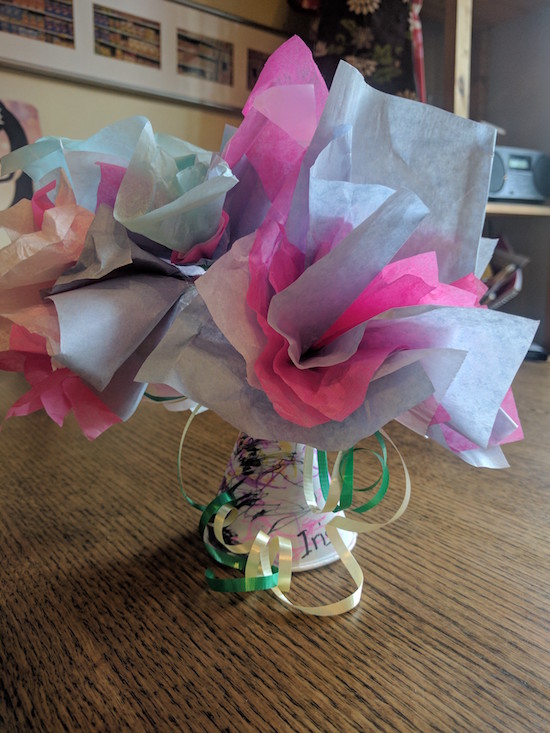
On Mother’s Day, I am grateful for my abortion. Which might sound intentionally provocative, but it isn’t. If you think very hard you might be able to fathom the banality of being grateful for this one thing upon which my adult life has hinged, from which everything since has come from, every single ordinary wonderful thing. Although I wasn’t always grateful—at the time such a thing as gratitude never occurred to me. To have the freedom to make a decision about my own body and my own destiny—that sounds kind of banal as well. It was 2002 and things were politically different, or at least I was isolated enough to think they were. At the time it wouldn’t have occurred to me that The Handmaid’s Tale was prescient.
But none of that is actually what I’m thinking about today, in 2017, amidst the conversations about cultural appropriation I’ve been listening to all for the last few days—except for yesterday when I took a blessed internet sabbatical. Instead, I am grateful for my abortion for another reason, for the ability my experiences of abortion and motherhood have given me to grasp nuance, hold uncertainty and hold two ideas in my head at once. “A single thing can have two realities.” My abortion enabled me to articulate this idea, to come to know the necessity of in-betweeness. It’s a point of view that many people a great deal smarter than I am have still not been able to grasp.
I was thinking about this this morning as I read [Redacted; a person not worth thinking about specifically]’s remarkable twitter timeline which must have originated in defence of her son who has been called out for supporting a “cultural appropriation prize” in defence of another editor who has (seemingly) been set-upon by the twitter mobs. I’ve never seen such an example of one misguided offensive thing spiralling into a whirlwind of absolutely abhorrent behaviour, the kind of behaviour that would embarrass a daycare room of toddlers, with apologies to toddlers. [Redacted] daring to make a terrible thing even worse by for some reason claiming that positive experiences of Indigenous people in Canadian residential schools had been censored from the official report, which [Redacted] hasn’t even read. (“Is there no subject matter you don’t know about that you feel qualified to opine on?” asks Maggie Wente on Twitter.)
It was all so preposterous that I did the thing that no one should ever do, which is click over to [Redacted]’s timeline where she was retweeting some guy who’d tweeted, ‘Nothing says “I love you, mom” like a child you didn’t abort.’ And here, I thought, was exactly the problem. A person who’d think that was the reality of abortion and motherhood would be the person limited enough not to understand how one could support free speech and respecting Indigenous cultures. Not to see that Black Lives Matter means that all lives matter. The kind of person who doesn’t seem to get that you can find female genital mutilation appalling and still not be a raging racist, or even be a feminist who supports the right of other women to do what they like with their bodies—adorn it with a headscarf, even. That women who have abortions might be the same women who’ve mourned miscarriages, or who celebrate life-saving techniques that make it possible for babies born as early as 23 weeks to go on to thrive. These are also, I must point out, the same people who REFUSE to understand that most late-term abortions are performed on babies that were desperately wanted but nonviable due to fetal abnormalities. People who don’t get that a person like me who was so grateful for her abortion at six weeks can understand that for many women “choice” can be the lesser of two tragedies.
I am grateful for my abortion, because my experience as a pro-choice woman has informed so much of my understanding of power structures and oppression . It’s why I’m not sure “debate” is the answer, because I’ve had to stand on the street corner “debating” my bodily autonomy with a twenty year old Catholic boy, and I’m not sure it really got me anywhere. It’s why I know that “Yes, but…” is usually a better answer, and that sometimes we have to acknowledge that people really are the experts on their own lives and experiences. That listening is usually the best course. That we all have a lot to learn from each other. That sometimes the things that make us uncomfortable are the real things, and that grey areas exist for a reason and we have a lot of discover where they do.
If not for my abortion, I might think that questions have easy answers, that the world has easy answers, that life is uncomplicated, tidy and straightforward. I might not even understand that this can be true: if not for my abortion, I wouldn’t have my children. So on Mother’s Day, I’m more grateful than ever.
April 24, 2019
The Myriad Nature of Maternal Grief
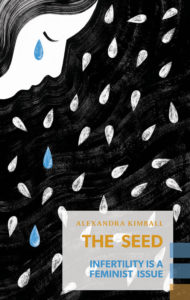
Everything I know about infertility, I’ve come to understand through the analogy of abortion, which is not the opposite of infertility—though some people might have you imagine so. For your information, adoption and miscarriage are not the opposite of abortion either, as the many people who’ve had both abortions and miscarriages can definitely attest, and those women who’ve experienced adoption too. (And pay attention here, to the challenge of going beyond a single story in women’s experiences—a theme. To an insistence in our rhetoric on either/or, and maybe neither if you’re lucky, but never both.)
While I’ve not experienced infertility, I have had an abortion, which means that I’ve spent a lot of the last seventeen years thinking about reproductive choice (which delivered me the rest of my life, after all, so I spend a lot of time saying thank you). And in this thinking it occurred to me that such notions of choice must necessarily include women who want to be pregnant but aren’t, women I feel solidarity with because both experiences (wanting to be pregnant when you’re not and not wanting to be pregnant when you are) have feelings of grief and such abject despair at their core. And similarly do abortion and infertility attract the wrath of patriarchal forces, because there is nothing our society likes less than a woman who exercises agency over her destiny, who refuses to be a passive vessel.
(An additional commonality I’d never considered until reading Alexandra Kimball’s book is that abhorring abortion and dismissing the trauma of infertility both require diminishing the physical labour required to be pregnant and also that to become pregnant through reproductive technology. Abortion and infertility treatments are both considered, by those who don’t know any better, as a matter of simple “convenience,” equivocating women’s labour with, just say, a breakfast sandwich from Starbucks.)
And so Alexandra Kimball’s The Seed: Infertility is a Feminist Issue was always going to one of the books I’ve most been looking forward to this spring. (The first time I read Kimball’s work was a 2015 essay on miscarriage, which was also about her abortion, and I am always interested when abortion/miscarriage/infertility are part of the same conversation; and note: they were also all part of the conversation in the anthology I edited in 2014, The M Word: Conversations About Motherhood).
But I will admit that while I was looking forward to The Seed, its thesis (that feminism has failed infertile women) made me uncomfortable—and certainly it’s even supposed to, and it’s provocative. But what I mean is that I didn’t start reading the book completely on board, and I felt its central premise would possibly be a bit overstated. (This is kind of like when you’re white, and a racialized person tells you about their experience of racism, and you suppose they’re just being a bit sensitive.)
But it was by about page 50 and her analysis of The Handmaid’s Tale and infertility in pop culture (after the chapter on infertile women as monstrous in myth and folklore, beginning with a Babylonian epic from 18th century BC, right up to witchcraft trials just a couple of hundred years ago) that Kimball had me convinced that she was not just being sensitive. After discussing pop culture infertility in films like Fatal Attraction and The Hand That Rocks the Cradle (infertile women literally destroying the everywoman’s life) she turns to The Handmaid’s Tale, and concludes that while it is “unequivocally, a feminist text…in its world, female barrenness is not only…threatening…disgusting… it is outright oppressive, a necessary engine for patriarchy itself.”
Kimball’s analysis from here is about the tension within feminism toward motherhood in general: “an idea of motherhood as conscription into patriarchy remained central to feminist theory and action.” And how feminism’s emphasis on CONTROL in terms of reproduction left little space for those women whose experiences were beyond their control—she quotes Linda Layne on the monumental Our Bodies, Ourselves, which included miscarriage and infertility in a separate (and unillustrated) chapter at end of the book.
And who exactly gets to be in control of their reproductive lives was quite specific from the start in feminist circles—racism and classism have always played a role in this. So that even now, the experiences of racialized, queer and poor people are alienated from conversations about fertility, which itself is alienated from conversations within feminism anyway. Kimball shows numerous examples of people in general and feminists in particular being much more concerned with and disturbed by ideas about people resolving their infertility than the problem of infertility itself.
And why is it so easy for our rhetoric to remain so unconcerned about the experience of the infertile woman? “They ignore the grief,” writes Kimball, who notes that she has never felt as objectified as she did when she was infertile. “It’s difficult to see [an infertile woman] as anything other than a curiosity of capitalism, akin to people who undergo cosmetic surgery.” She writes about “the existential clusterfuck of this trauma,” how the tragedy of infertility is that resolution always seems just close enough at hand to be worth pursuing. “It’s less of a biological impulse than a narrative one, a need for coherence and sense.”
And here, Kimball begins to see the possibilities of sisterhood, of solidarity, for she finds it with a friend who a trans woman whose own experiences have been very different but who understands the extent of Kimball’s grief in a way that few other people do. (Kimball also points out that Trans-Exclusionary-Radical-Feminists find women pursuing fertility as challenging to their politics as they do trans women.) She further identifies with the the artworks of Catherine Opie and Frieda Kahlo, how they portray bodily labour and grief. “I looked at Opie’s portrait series and Kahlo’s miscarriage works frequently when I was struggling, not so much because they mirrored my own experience or made me feel less lonely, but because I was heartened by what I felt was the complexity of their stories… They demonstrate the myriad nature of maternal grief.”
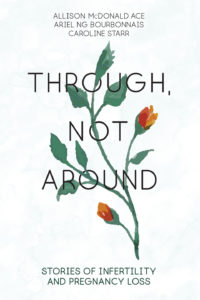
That myriad nature is explored in the essay anthology Through, Not Around: Stories of Infertility and Pregnancy Loss, edited by Allison McDonald Ace, Ariel Ng Bourbonnais and Caroline Starr, a work that challenges “the single narrative” that Kimball complicates and writes against in her cultural analysis. In Through, Not Around, the political is made personal again with 22 stories of infertility, miscarriage and stillbirth, mostly by women, but with a handful by men. Each writer is telling a story that is far from uncommon, but which was until recently taboo (and even remains so in many cultures). As Kimball writes, society is made uncomfortable by evidence of the effort and labour of motherhood, would prefer it to remain hidden so we can continue to believe it is natural, essential.
My only critique of this collection is the lack of contributor bios, because it would be interesting to see what a range of backgrounds these writers are coming from. (Although I try to think of reasons why contributor bios might be avoided here, and I can think of some answers. What happens when we let the stories speak for themselves?) My sense is that these writers come from a fairly broad spectrum of experience (although, for reasons Kimball has illuminated, racialized, queer and poor women are in the minority here, as they are in conversations about fertility in general) and that most of them are not professional writers. (The anthology was born of the online community The 16 Percent.) And so I was impressed by how excellently written most of these essays were, how they made stories out of experiences that defy the conventions of narrative at every turn. (There is a reason you rarely read a novel where someone ends up having five miscarriages.)
The grief that Kimball writes about is evident in these essays, which are stories of strength and resilience under sometimes unrelenting pressure. The point indeed is getting through, which requires action instead of passiveness. But also questions of when to try a different path forward, when to stop, and all the surprising diversions that happen along the way. Women’s lives, we read in these essays, are fraught and brutal and hard and knit with tragedy, but are also unfailingly interesting.
There are so many ways to be a woman, and to become a mother, or to be infertile, even. I’m grateful to both these books for complicating the narrative in the very best way.
April 1, 2019
The Narrative Value of Abortion

I am still not finished writing about abortion (or talking about abortion), not least because writing about abortion/ de-stigmatizing abortion / acknowledging abortion as ordinary is more important than it’s ever been with women’s reproductive rights and access to abortion under threat in a way I never anticipated they would be when I had my own abortion 600 years ago and even had the nerve to take my access to abortion for granted—how very 2002/”post-feminist” of me, right?
And there, I just used “abortion” eight times in a sentence, which I think was the general guideline put forth by Strunk and White in their Elements of Style. Something along the lines of, “Write abortion eight times in a sentence, then go do seven impossible things before breakfast.” (For six and under, you’re pretty much on your own.)
I keep writing about abortion because people with no experience of abortion keep trying to make laws about abortion, and the tyranny and injustice of that terrifies me. But I also keep writing about abortion, in fiction in particular, because it’s really interesting from a narrative point of view. As Lindy West writes in Shrill, ‘My abortion wasn’t intrinsically significant, but it was my first big grown-up decision—the first time I asserted unequivocally, “I know the life that I want and this isn’t it”; the moment I stopped being a passenger in my own body and grabbed the rudder.”’ And from a character-development standpoint, such a moment is pure gold for an author, along with the nuance and ambiguity that comes with the experience of abortion. The defiance, the agency, the courage—these qualities are what character is made of. And the variable ways an abortion is experienced by a couple too, if the pregnant person finds herself in that kind of arrangement. How it could bring two people together, or push them apart, or make clear a reality that’s been present all along.
The possibilities are endless, as to what can happen to a woman (fictional or otherwise) who has an abortion, and endless possibilities are kind of the whole point of abortion anyway. And not that all those possibilities are free and easy—what choice in any life ever comes with such certainty? But it’s about plot and richness and tension and balance, and knowing that a single thing can have two (or more) realities, that a reality can be true and not true at once, which is the entire jurisdiction of fiction.
So I am not finished putting abortion in my work, because of the fact of abortion in the world, regardless of whether or not it makes you uncomfortable. And maybe in this instance, your comfort is not the point? Instead, for the reader, finding abortion in our fiction brings home the ordinariness of abortion in the places where we live—our homes, our families, our small towns and big cities. Writing about abortion is not a question of changing the world, but instead of catching up with it, acknowledging the reality what life has been like all along.
March 8, 2019
The Secret Life of Alice Freeman…
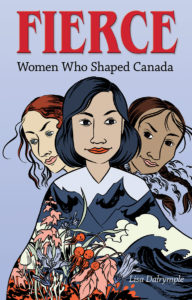
Today at 49thShelf, we’re featuring an excerpt from new book Fierce: Five Women Who Shaped Canada, by Lisa Dalrymple and illustrated by Willow Dawson, which is a book I’ve been reading aloud to my family over the last two weeks, and one we’re all enjoying. In particular the story of Alice Freeman, Toronto schoolteacher in the 1880s who led a secret double-life as an investigative reporter. It’s so good, and you can read it here.
January 23, 2019
We Hold Each Other Up

I like people in theory, but I have to tell you that in practice, I find a lot of them kind of annoying. Which makes me despair sometimes, because this is a political moment in which solidarity, allyship, and cooperation have never been more necessary. And what can you do at a moment like that when you’re kind of a misanthrope? Which is overstating it a bit, I realize. People are fine, but it’s not like I want to invite every single one of them over for dinner, you know? I’d rather read my book than chat to a stranger on the subway. I’ve unfollowed people on social media for being on a juice cleanse. I don’t want to deprive anyone of their juice, but I reserve the right to not to have to hear about it.
So I felt a bit strange about the Women’s March held in Toronto this Saturday, kind of inauthentic as a political person, the kind of who has a pot of chilli perpetually simmering on the stove and everybody is welcome at her table always. I feel uncomfortable aligning myself with political movements, with partisanship, even though I realize that failing to understand that politics is everything has never ever changed the world. I still resist the idea of chanting in a crowd of people, scripted call and responses. Even though I know that such noise can be revolutionary, and there is so much that really has to change. I do believe that this is a historical moment in which it’s necessary to declare what side you’re on, and I know what side I’m on. As per the sign I carried on Saturday, I marched for midwives, Black lives, clean water, Indigenous rights, sex-ed, public schools, for teachers, for the environment, for justice, and so much more. This is my feminism. I was there for my city, my province, my country, for my daughters. (And so grateful to the people who did the work and made the march happen, who were too busy with boots on the ground to be hemming and hawing about simmering chilli.)
It was a joyous occasion, albeit one held in a snowstorm. But we were prepared with multiple pairs of pants, and scarves plus neck warmers, and before we marched, we had breakfast at Rebecca’s house, where she had poster-making supplies, and we all got to work. (Because fighting the patriarchy is more fun with friends.) We arrived to hear the last few speeches, and then to join the parade up University Avenue to Queen’s Park, snow piling on everybody’s hats and heads. I pulled up my hood with its furry trim, and loved the cocoon of it. That I couldn’t properly hear or see what was going on around me (hoods are the enemy of peripheral vision), and everybody else was tucked inside their own hoods, each of us in our separate warmths, and yet moving all in the same direction together.
And it was that simple. We didn’t need to have chilli. At the end of the march, we’d all go our separate ways, most of us on public transit. But the march was a reminder and a commitment to the fundamental ways we are all of us connected whether we want to be or not, however uncomfortable it makes us sometimes. Because people aren’t easy, but people are the project, the point of it all. We don’t all have to be friends, but we have a responsibility to still care for each other, to listen to each other (which is not the same thing as having to agree). Because, as Iris’s sign said, riffing off a book we love, We Hold Each Other Up. And it will never not be interesting.
